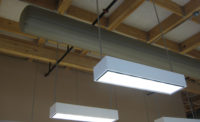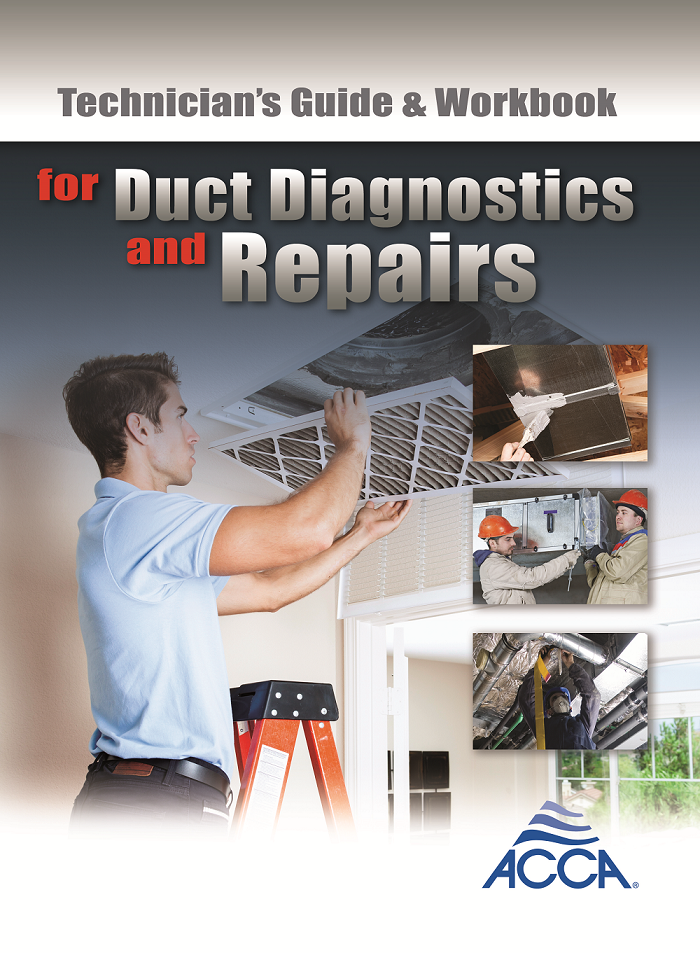The call came in April 2004, less than a year after the owner of Ace Heating and Cooling, Long Island, N.Y., had installed a 2-ton, 14-SEER Rheem split system in a prefab ranch home in Mastic, N.Y. Knowing that the system was not running for the cooling season yet, Logue went to the frustrated customer's home to see what was going on.
"On arrival, we drained six gallons of water in our flex runs by removing each flex from the ceiling grilles and draining the water into buckets," said Logue.
Before leaving, the contractor repaired all sheetrock that was damaged and painted where necessary. He went back to the house at the end of June for the spring startup, removed the seal from the return, and found no moisture in the ductwork. It appeared all was taken care of, as there was not a complaint all summer.
Unfortunately, the same situation cropped up before the end of the year. "On Thanksgiving weekend, we received a call from the angry homeowner, saying water was coming out of her vents, again," said Logue.
What To Do?
To make matters worse for the contractor, the homeowner had called a home inspector/engineer, who proceeded to diagnose that the air handler was not draining the condensation and his recommendations were to change the air handler and ductwork."He also stated that a mold problem could start in a short period of time," said Logue.
A Rheem representative contacted the engineer to explain that the air handler was not the issue, but humidity and dew points. However, the engineer believed there was no way his findings were incorrect.
"The engineer's findings created a problem between the homeowner and myself," said Logue. "Obviously, condensation water pitched downward could not defy the laws of gravity, flowing up through the supply trunk and not getting the supply trunk wet, but depositing water into the flex runs."
What was confusing to Logue was the fact there was no water in the evaporator condenser pan or emergency pan.
At this point, Logue contacted many manufacturers and the North American Insulation Manufacturers Association (NAIMA). It was here that he learned about these conditions that occur in the winter months in unused ductwork in cold attics.
"My findings are that this is a very rare condition, but it happens in every state," said Logue.
NAIMA To The Rescue
According to NAIMA, during the heating season, unused air conditioning ducts located in unconditioned spaces can become saturated with water unless certain precautions are taken. Low duct temperatures can result in condensation, which can accumulate during the winter months.According to NAIMA, the source of liquid water in unused or nonoperating ducts is the air within a home. All air contains some water in the form of water vapor.
"However, in winter, inside air typically has more water vapor than outside air because warm air can hold more water vapor than cold air," said Charles Cottrell, vice president, technical services, NAIMA. "When water vapor-laden air cools to a low enough temperature, it condenses, forming liquid water. This is more likely to happen when ducts located in unconditioned spaces, like attics, are not adequately insulated, and the air in them is not circulated on a regular basis. Having the fan circulate warm air through the duct system can reduce the likelihood of a problem, but is not a certain cure."
It doesn't matter what the duct is made of either, said NAIMA - be it bare sheet metal, fiber glass-lined sheet wrap, wrapped metal duct board or flexible duct: The physical laws governing this phenomenon are the same for all materials.
What Logue found out is that ducts without heated air flowing through them will cool to temperatures near that of the unconditioned space. Insulation, by itself, will not keep unused duct temperatures elevated or stable.
According to NAIMA, insulation will slow down the rate of heat flow through the duct wall, but unless this heat is replaced, the temperature in the duct will fall. When the temperature falls low enough, the moisture-laden air from within the home will begin to lose its moisture and form condensation.
Unless heat is supplied to the inside of the duct, said NAIMA, condensation will continue to form and water will begin to accumulate within the duct. If the temperature of the duct surface is low enough, condensation and possibly frost and ice will form, cautioned NAIMA.
Not until the unconditioned space warms up and the ice melts will the problem become evident, explained NAIMA.
Seal Those Ducts
The association recommends that unused duct systems be sealed during the heating season. Just closing dampers will probably not be sufficient, it said. Dampers are not airtight and will allow the moist air to move into the duct.It is recommended that all duct openings, supplies and returns, be sealed to prevent intrusion of both air and vapor. This means removing the register or return grille and taping the duct opening closed. Taping plastic sheeting over the openings can seal larger openings. In areas of high humidity, such as bathrooms and kitchens, care should be taken to ensure that complete seals are made.
Some people attempt to alleviate the problem by running a fan continuously for the duct systems during the winter months. The hope is that enough heat will be brought into the duct system to prevent condensation.
Although this may work in milder climates, NAIMA stated that this is not a guarantee and may even aggravate the problem by supplying much larger quantities of moisture-laden air to the cold duct. In addition, there is the increased cost to the homeowner because of the heat lost through the duct system.
Logue has since applied NAIMA's advice to the troubled customer's home and so far, so good. Not that he likes it.
"This is an imposition for the customer and contractor to go back twice a year to close the ducts for the winter months and open them in the spring," he said.
"In my opinion, if this condition is existing because of the moisture in the homeowner's home, then the customer should absorb the costs for the mechanic to return to seal and open the ducts because this condition will never go away."
In the attic, Logue was informed to remove the flex and tape off and seal the grills. But, to Logue, that did not seem like a permanent solution to the problem. To lessen the chances of condensation, he changed out all of the R-4 flex runs to R-8.
"We also sealed every opening on air handler, supply, and return boxes," said Logue.
For more information, contact NAIMA or visit www.naima.org. To reach John Logue, e-mail him at hvac11676@cs.com.
Publication date: 10/10/2005






